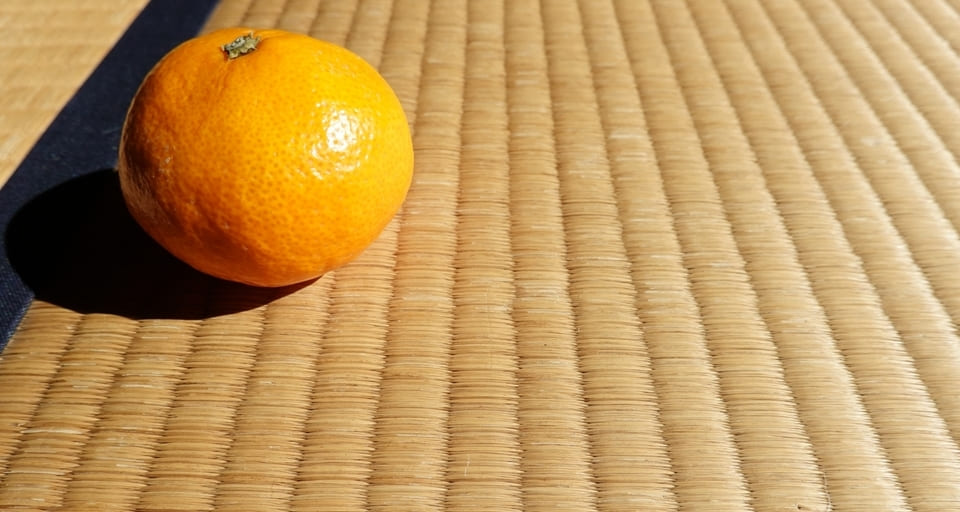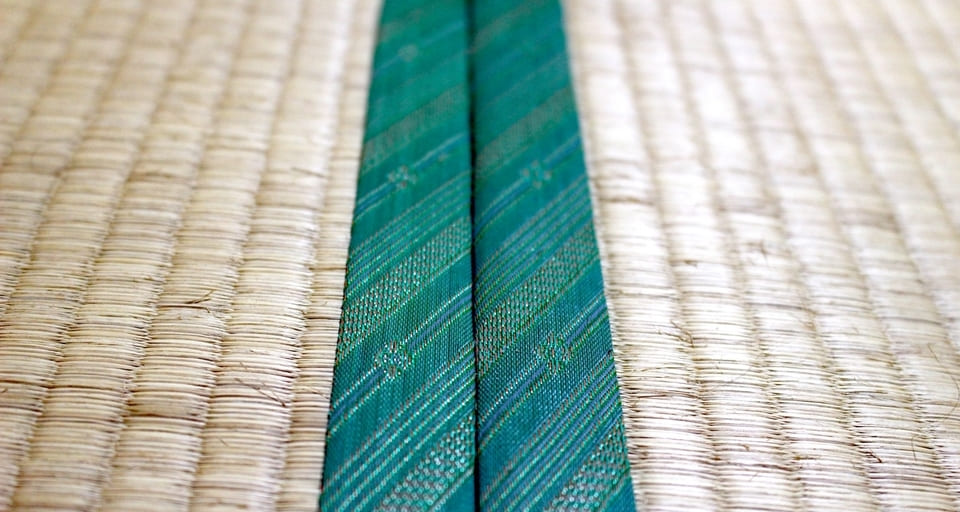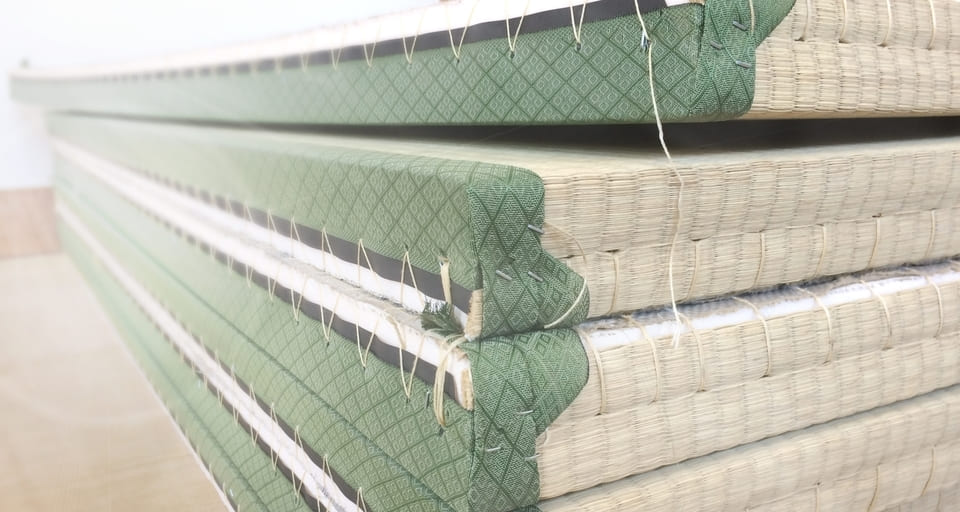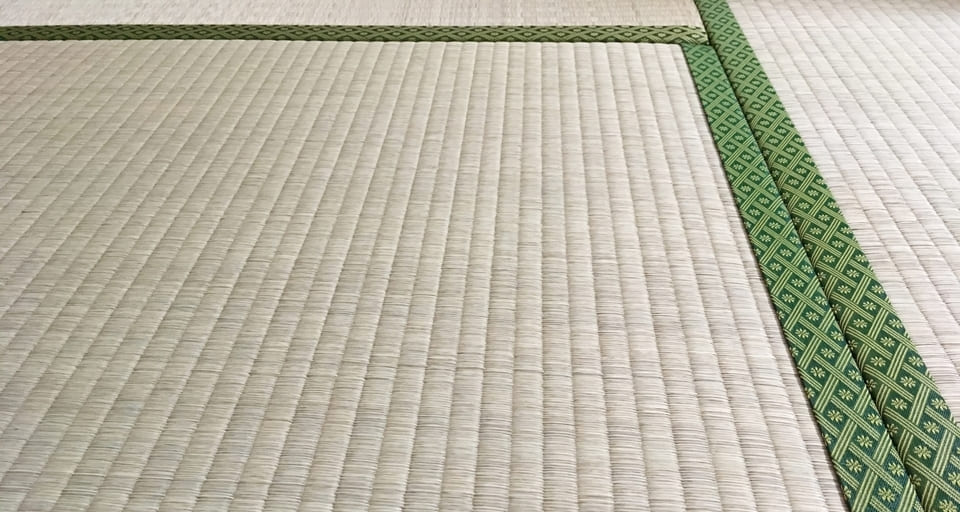In Japan, most people spend barefoot in their homes.
“Tatami(畳)” is a characteristic of a Japanese house where you spend barefoot. A room that uses tatami mats is called a “和室(Japanese-style room).” Not only in the house where we usually live but also in hotels and guest houses, there are Japanese-style rooms that use tatami mats. In this article, we will introduce “tatami,” which is familiar to Japanese people.
In this article, we will introduce a history of tatami mats and the manners of tatami. If you want to live in a house with tatami mats or you already live one, please also refer to the tatami mat cleaning method.
Overview and History of Tatami

In the first place, we will introduce what tatami mats are, and the history and characteristics of tatami mats.
What is Tatami Mat?
Tatami is one of the bedding materials used in Japanese-style rooms. Unlike flooring that uses wood as the material, tatami mats are floor materials that use “igusa(rush)” as the material.
Traditional Japanese tatami mats consist of a tatami floor, which is made by stiffening straws with threads, and the surface is wrapped with a tatami mat that is woven with igusa. The shape is mainly rectangular, and the edges with color and pattern are sewn on the long side.
In the past, tatami mats used materials such as straw and igusa. But in recent years, various types of tatami mats have been made, such as wood chips and chemical fibers, according to the intended use and demand. In recent years, igusa made in China has also been widely used.
Japanese Tatami History
The Japanese tatami has a long history, and the oldest tatami mat in Japan is said to be from the Nara period.
The Nara era dates from 710 to 794 AD, and there is the Todaiji Temple as a historical building. Todaiji Temple is recognized as a UNESCO World Heritage Site and is a popular tourist destination overseas along with the Great Buddha of Nara, so many of you may know it.
Tatami has been passed down as a Japanese culture for about 1,300 years since the Nara period.
Why Tatami Became Popular in Japan
One of the reasons why tatami mats have spread in Japan is the climate of Japan.
A characteristic of Japan’s climate is that it is humid throughout the year, with hot summers and cold winters. Tatami mats are suitable flooring material for these climates.
Tatami has the effect of controlling the humidity and blocking heat. A tatami mat that keeps moisture from the ground and keeps it at an appropriate temperature is suitable for the Japanese climate. It started as an aristocrat in the Nara period and spread widely among the general public in the Edo period.
However, in the era of high economic growth, the demand for tatami mats decreased as Japanese houses became westernized. This is because the cost of making a Japanese-style room such as tatami mats and shoji was higher than that of a Western-style room.
However, in recent years, the functions of tatami mats have been revisited, and even in western-style houses, some of the rooms have become Japanese-style rooms, and the value of tatami mats has been re-recognized.
With the increase in the number of foreigners and foreign tourists living in Japan, the number of hotels and guesthouses that have Japanese-style rooms that use tatami mats is increasing as people who can experience Japanese traditional culture.
Manners in a Tatami Room

As the number of tatami rooms has decreased since the era of high economic growth, few Japanese know the manners of tatami rooms. Therefore, even if a foreigner breaks manners in a tatami room, the other person may not notice it.
However, those who value manners in tatami rooms, especially those who are deeply involved in traditional cultures such as tea ceremony and flower arrangement, place great importance on manners in tatami rooms.
When interacting with such people, if you know the tatami etiquette, you will be able to build a good relationship. Here we will introduce the manners for that purpose.
Basic Tatami Manner
One of the basic manners of tatami mats is to “do not step on the edges of tatami mats.”
In the beginning, we introduced that the tatami mat has edges with color and pattern. It is the basic manner of a tatami room to not step on them.
There are various theories for that, but the most widely accepted one is that people avoided stepping on a family crest.
In a house that emphasizes the traditional style, the tatami mat has the family crest on its edge. Walking on it is considered to be a very rude act, as it is regarded as walking on the symbol of the house.
It is said that this is the reason that the etiquette of not stepping on the edge of tatami has become established. There is also a theory that people do not step on the edge of the tatami mat so that they can prolong the life of the tatami mat.
Japanese-Style Room Manners That are Convenient to Know
Here, we will introduce the manners of Japanese-style rooms.
Do Not Step on the Sill
The sill is the boundary between rooms. Japanese-style rooms have sliding doors called fusuma, and the part under the sliding door is called a “sill.”
The reason for not stepping on the sill is the same as the reason for not stepping on the edge of the tatami mat.
The sill is originally in the center of the house and is connected to the main pillar of the house. So it is considered to be associated with the owner of the house. Since stepping on a sill is the same as stepping on the owner of a family, it is considered etiquette not to step on it.
Do Not Step on the Floor Cushion
In a tatami room, you often sit on a cushion called “座布団(Zabuton)” instead of a chair.
Japanese people often sit straight on a cushion in a tatami room. When sitting on it, it is said to be a manner to sit straight on the side of the cushion first, and then move your knees on it to sit, instead of stepping on it on your feet.
Few Japanese people are used to sitting straight, so it is unlikely that foreigners will be forced to do that. Still, don’t step on the cushion with your feet.
How to Clean the Tatami Mat

Tatami has the function of preventing moisture and keeping the room comfortable. On the other hand, the tatami mat itself has the property of being easily damaged, but with proper care, it can be used for decades.
Here, we will tell you the basic care and cleaning methods for tatami mats and points to note.
Basic Cleaning Methods for Tatami Mats
The basic cleaning methods for tatami mats are “use a vacuum cleaner” and “wipe with a dry cloth.” We will introduce them together with the notes.
Use a Vacuum Cleaner
The basic way to clean a tatami mat is to vacuum it. Please do it like a flooring room.
The point to note is to vacuum along the direction of the tatami mat.
If you don’t vacuum it along the direction, you may damage the tatami mat and edges.
Wipe with a Dry Cloth
Tatami has the property that it easily absorbs water. When wiping it, do not use a rag that is wet with water, and use a dry one.
If you spill a drink such as juice or coffee, it will cause stains, so be careful when eating and drinking in the tatami room.
If you accidentally spill your drink, wipe it with a tightly squeezed rag. Wipe after the spilled drink along the lines of the tatami mat and then wipe with a dry cloth to remove water.
Precautions When Using Tatami
We will also introduce the points to note when using tatami mats.
Do Not Lay Carpets or Rugs
Tatami itself has a role in controlling humidity. However, if a carpet or rug is laid on it, the moisture will not escape and may cause ticks and mold.
Therefore, do not put carpets or rugs on the tatami mat.
Do Not Use Baking Soda
There is a method of using baking soda to remove oil stains on the kitchen and sebum stains on the flooring. However, avoid using baking soda on tatami mats.
Baking soda causes the natural ingredients of igusa to turn yellow, and it also causes darkening. If you want to get rid of heavy dirt on tatami mats, use citric acid.
Conclusion
Tatami has been used in Japanese houses for a long time and is the most familiar Japanese traditional culture.
Now many homes are made with flooring and Western-style rooms, but many Japanese feel calm on tatami mats.
At first glance, it is a manner and cleaning method that feels difficult, but if you keep the basic things in mind, it is not so difficult. When using a tatami room, please refer to the information in this article.
If you are looking for a house to live in Japan, it might be interesting to look for a room with tatami mats.



